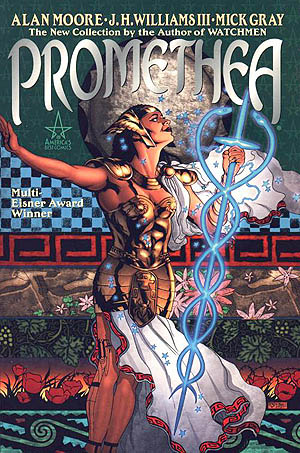Promethea
Book 1
Down from the Attic: 4

Back in the day, before Promethea went into the Attic, not to emerge for another fifteen years, this was the Alan Moore comic series that I had expected to have the most difficulty with. Now I can’t remember why, much less the reason I never bought Book 2. Life just got in the way, perhaps.
I seem to remember that a lot of the fans that I met in Dublin’s Forbidden Planet and then when I moved to Galway, Sub-City, didn’t seem to have been as enthusiastic about this myth-heroine as – say, for example – Watchmen. I loved her, though. I was entranced and enchanted and all that good stuff. And the book teamed the wonderful writing and imagination of Moore with the beautiful artwork of J.H. Williams III and Mick Gray. An absolute treat, that alone.
It also occurs to me now that Promethea going into the Attic in order to wait for a period of renewal isn’t a bad analogy for a character that had literal periods of hibernation herself, before emerging a-fresh from a brand new imagination.
That imagination this time around belongs to University student, Sophie Bangs. In Promethea: Book 1 (which collects the first six issues) this is a young lady in Moore & Williams’s alternative 1999 New York who finds herself plugged in to a sort of global imaginative realm, where stories are made flesh, called the Immateria. Sophie has been writing a term paper on this character that she has become fascinated by:
“The same name turns up in 18th century poems, early newspapers strips, pulp magazines and comic books. That’s interesting.”
Promethea was once a real child in Alexandria, 411 A.D; but her magician father deemed it necessary for her to leave the material plane in order to save her life – and also to fulfill some unspecified higher destiny:
“Only in my world, the Immateria, can I protect you; and there you would no longer be a little girl. You’d be a story. You would live eternally, as stories do. As for coming back, well…sometimes, when a story is very special, it can quite take people over.”
Indeed. And from 1779 onward Promethea becomes a material, if Goddess-like, being to several people of vivid imaginations. There have been five – possibly six? – incarnations before Sophie. And all of them still exist. From the Immateria they observe Sophie as she adapts to her new self. All of them are Promethea; and all of them have their own distinct personalities. Yet those personalities are the creation of the artist who imagined them…aren’t they?
Words bring them through. Words and illustrations. The cartoonist Margaret Case chooses to help dying young World War I soldiers, in an incarnation that is obviously inspired by the great Arthur Machen’s famous short story The Bowmen, which inspired the legend of the Angel of Mons.
And I just love Grace Brannagh, who had been a pulp magazine illustrator and exists in her own kingdom of Hy Brasil as a formidable sword-and-sorcery heroine, created by hack writers:
“Nothing but blasted Manigators. You’d think I’d never fought anything else! Doesn’t he remember ‘Promethea and the Screaming Cloud?’ Or those leopard boys from ‘Claws of the Cat-Cult’? Now, actually, they were rather dishy.
“Neptura’s ‘Eyrie of Evil’. I mean, do you see what I’m saying about his writing? Dreadful name. What’s worse, the place used to be my bed chamber. That’s why he occupied it. The poor creature’s utterly besotted with me. All that drivel he wrote about my taut thighs and heaving bosom. I mean, I don’t remember my bosom ever having heaved. Has yours?”
One of the many sideshows to love about Promethea is the ongoing background noise. There is a sleaze-embattled multiple personality New York Mayor:
“Meanwhile, [in other news] one of Mayor Sonny Baskerville’s multiple personalities, a shy albino named ‘Doug’, has confessed to charges of molestation. Doug maintains, however, that he himself had first been molested by another personality called ‘Big Ruby’. The case continues.”
Then there is a simply wonderful creation called ‘Weeping Gorilla’. This is a gorilla who perpetually – well – weeps, whilst coming out with totally downbeat soundbites:
‘Go on; ask me about my marriage’/ ‘Why do pets have to die?’/ ‘I hate my body’/’Can we hear that Radiohead track once more?’
Promethea was, I believe, the second title from Alan Moore’s America’s Best Comics line which he started in 1999. Another title, Tom Strong, is reviewed by me in Down from the Attic: 1. As with that title, the lettering here is exquisite and again by Todd Klein.
___________________________
Rediscovering Moore
It seems as if, ever since that fateful trip to the Attic last Christmas (which has gained in my mind the stature of the children finding the magical wardrobe), I seem to have been rediscovering Moore.
The last time I took more than a casual interest, he was in his early fifties, fresh from his triumphs with V for Vendetta and Watchmen; and had just declared himself a snake-god worshipping magician; and as I write this review it’s coming back to me that Promethea was the title where he began to introduce people to his magical ideas.
I’ve heard that he’s since then become a cranky, grouchy old guy in his seventies, who has completed writing a million word novel called Jerusalem (which apparently makes James Joyce look perfectly accessible); but I think it’s time to find out for myself –especially as I also hear we are about to get a Lovecraftian comic book from him called Providence.
How mouth-watering is that?
First though, there’s more to come down from the Attic.
Next: Will Eisner’s A Contract with God.

Recent Comments